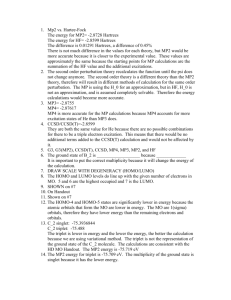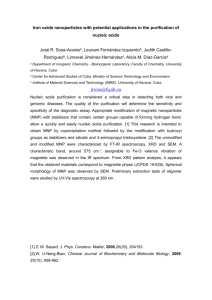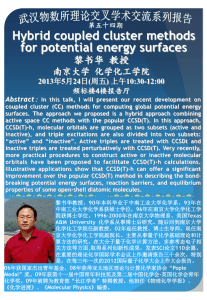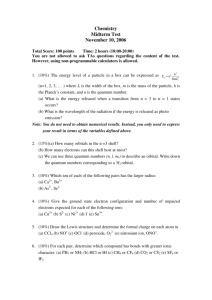SUPPLEMENTARY MATERIAL Equilibrium vs. Ground-State Planarity of the CONH Linkage Jean Demaison,
advertisement
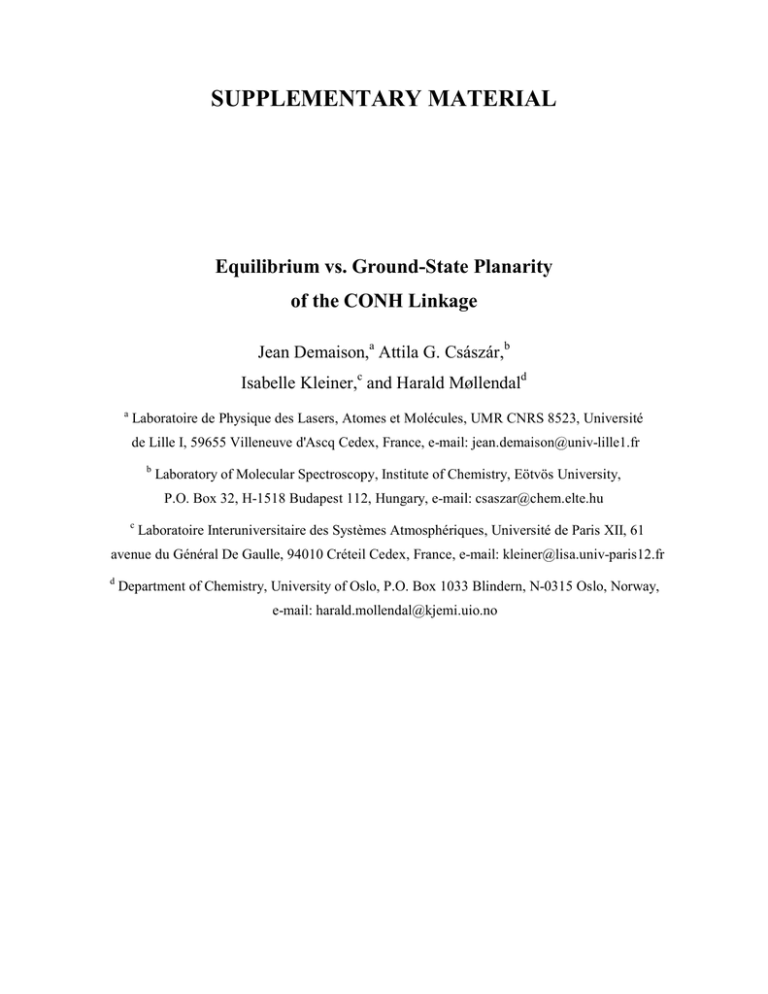
SUPPLEMENTARY MATERIAL Equilibrium vs. Ground-State Planarity of the CONH Linkage Jean Demaison,a Attila G. Császár,b Isabelle Kleiner,c and Harald Møllendald a Laboratoire de Physique des Lasers, Atomes et Molécules, UMR CNRS 8523, Université de Lille I, 59655 Villeneuve d'Ascq Cedex, France, e-mail: jean.demaison@univ-lille1.fr b Laboratory of Molecular Spectroscopy, Institute of Chemistry, Eötvös University, P.O. Box 32, H-1518 Budapest 112, Hungary, e-mail: csaszar@chem.elte.hu c Laboratoire Interuniversitaire des Systèmes Atmosphériques, Université de Paris XII, 61 avenue du Général De Gaulle, 94010 Créteil Cedex, France, e-mail: kleiner@lisa.univ-paris12.fr d Department of Chemistry, University of Oslo, P.O. Box 1033 Blindern, N-0315 Oslo, Norway, e-mail: harald.mollendal@kjemi.uio.no Table of contents Note that Table Sn in the Supplementary material corresponds to Table n (n = 1,…,9) of the manuscript. Table S1. Molecular structure of formamide, HCONH2, with distances (r) in Å and angles (∠) in degrees. Table S2. Structure of cyanamide, H2NCN, with distances (r) in Å and angles (∠) in degrees. Table S3. Structure of acetamide, CH3C(O)NH2, with distances (r) in Å and angles (∠ and τ) in degrees. Table S4. Structure of urea, OC(NH2)2, with distances (r) in Å and angles (∠ and τ) in degrees. Table S5. Structure of carbamic acid, H2NCOOH, with distances (r) in Å and angles (∠ and τ) in degrees. Table S6. Computed Born–Oppenheimer equilibrium structures of methyl carbamate. Table S8. Comparison between predicted and experimental rotational constants (in MHz) of methyl carbamate. Table S9. Computed equilibrium and experimental ground-state dipole moment components (in debye) of methyl carbamate. Table S17. Observed and calculated vibrational fundamentals (in cm−1) for methyl carbamate. Table S18. Computed structures of dimethylether, (CH3)2O, distances (r) in Å and angles (∠) in degrees. 2 rm(2) SBR g re f rs e reBO MP2_AE B3LYP MP2_FC CCSD(T)_AE This work CBSd 1.354 1.352 1.358(3) 1.361(4) 1.3547 1.3695 1.3608 1.3578 1.3547 1.3560 1.3565 1.3544 1.3547 1.3552 1.3543 1.3544 1.3517 1.3571 CCSD(T)_FC VDZ VTZ VQZ V(T/D)Z VTZ AVTZ VQZ VQZ AVQZ V(5,Q)Z c wCVQZ wCVQZ VTZ r(C–N) Methoda 1.212 1.219 1.2139 1.210(4) 1.2097 1.2196 1.2140 1.2117 1.2106 1.2108 1.2120 1.2094 1.2132 1.2146 1.2134 1.2129 1.2107 1.2094 r(C=O) 1.003 1.002 1.0069 f 1.005(2) 1.0033 1.0153 1.0050 1.0043 1.0117 1.0029 1.0036 1.0024 1.0035 1.0043 1.0042 1.0035 1.0025 1.0064 r(NHs)b 1.000 1.002 1.0043 h 0.984(4) 1.0006 1.0124 1.0023 1.0017 1.0088 1.0002 1.0012 0.9997 1.0007 1.0016 1.0015 1.0008 0.9997 1.0038 r(NHa)b 1.097 1.098 1.106 h 1.112(3) 1.1001 1.1198 1.1025 1.1015 1.1087 1.0973 1.0973 1.0990 1.0992 1.0992 1.0994 1.0992 1.0977 1.105 r(CH) 125.0 124.7 124.61(10) 124.8(4) 124.63 125.03 124.89 124.71 125.01 124.95 124.79 124.73 124.74 124.62 124.65 124.74 124.74 125.02 ∠OCN 119.3 118.5 119.4(16) 117.8(3) 119.18 119.02 119.22 119.20 119.22 119.25 119.28 119.21 119.19 119.25 119.20 119.18 119.16 119.41 ∠CNHs Table S1. Molecular structure of formamide, HCONH2, with distances (r) in Å and angles (∠) in degrees. 121.1 119.9 121.35(58) 121.8(5) 121.09 121.41 121.08 121.08 121.06 121.12 121.11 121.12 121.09 121.09 121.06 121.09 121.10 121.32 ∠CNHa 112.3(20) i 112.0 112.7 112.53 111.58 112.21 112.49 112.20 112.21 112.41 112.51 112.43 112.60 112.56 112.44 112.49 112.17 ∠HCN Assuming the validity of the following additive corrections: VQZ CCSD(T)_FC + [V(5,Q)Z – VQZ] MP2_FC + [wCVQZ MP2_AE – wCVQZ VQZ on H atoms and V5Z on all other atoms. s = syn (resp. a = anti) with respect to C=O bond. FC = frozen-core approximation, AE = all electrons correlated. i h g f e Not determined. Fixed at the MP2/6-311G(d,p) value. SRB = semirigid bender model, Ref. 43. Ref.. 6. Ref. 3. 4 these improvements is also reported in Table 1. MP2 level, and for the effects caused by the use of a more complete basis, estimated at the V(5,Q)Z MP2 level. The structure corresponding to within the frozen-core approximation may be improved by correcting them for the effects of inner-shell correlation estimated here at the wCVQZ order to estimate the effects of core correlation, the cc-pwCVQZ basis set was used at the MP2 level. The structural data for FA computed decrease being as small as 0.0004 Å for the C–N bond length, whereas for the C=O bond length there is a negligible increase of 0.0002 Å. In Improving the basis set from VQZ to V(5,Q)Z, again at the MP2 level, shows that convergence is practically achieved at the VQZ level, the MP2 level, leads to an almost negligible change in the structural parameters, except for the C=O bond length, which is increased by 0.0014 Å. the largest variation is observed for the C–N bond length, which is shortened by 0.0031 Å. Taking diffuse functions into account, at the AVQZ MP2_FC]. Improving the basis set from VTZ to VQZ in the CCSD(T) optimizations shows that convergence in the structure is almost achieved, d c b a Table S1 cont. Table S2. Structure of cyanamide, H2NCN, with distances (r) in Å and angles (∠) in degrees. τf Methoda r(C≡N) r(N–C) r(N–H) ∠HNC CCSD(T)_FC VDZ 1.1801 1.3736 1.0225 110.52 119.56 176.47 VTZ 1.1655 1.3577 1.0101 112.49 116.70 176.80 VQZ 1.1621 1.3531 1.0086 113.08 115.81 176.86 VQZ 1.1689 1.3471 1.0074 113.44 115.31 176.73 A'VQZ b 1.1694 1.3474 1.0081 113.57 115.20 176.75 V(5,Q)Z c 1.1685 1.3456 1.0077 113.76 114.82 176.84 wCVQZ 1.1685 1.3468 1.0075 113.44 115.33 176.74 MP2_AE wCVQZ 1.1655 1.3433 1.0061 113.74 114.91 176.84 B3LYP VTZ 1.1548 1.3407 1.0091 115.15 112.80 177.24 reBO Best estimate d 1.1587 1.3482 1.0072 113.39 115.39 177.06 MP2_FC SRBe 1.1645 rs h 1.160(5) 1.346(5) 1.3301(5) 0.9994 5 g 1.001(15) 115.6 ∠NCN g 174.8 112.0 180g Table S2 cont. a FC = frozen-core approximation, AE =all electrons correlated. b cc-pVQZ on H and aug-cc-pVQZ on other atoms. c cc-pVQZ on H and cc-pV5Z on other atoms. d Assuming the validity of the following additive corrections: VQZ CCSD(T) + [cc-pwCVQZ(AE) – cc-pwCVQZ (FC) + cc-pV(5,Q)Z – cc-pVQZ] MP2. When enlarging the basis from VTZ to VQZ, the largest variation at the CCSD(T) level is found for the N–C bond length, which is shortened by 0.0046 Å. Improving the basis set from VQZ to V(5,Q)Z, at the MP2 level, shows that convergence is practically achieved at the VQZ level, the bond length decreases are as small as 0.0013 Å for the N–C bond and 0.0005 Å for the C≡N bond. Addition of diffuse functions at the VQZ MP2 level increases the N–C and C≡N bond lengths by 0.0003 and 0.0005 Å, respectively. These increases are quite small and, as they are expected to rapidly decrease with the size of the basis set, they should be completely negligible at the V5Z level. The currently most reliable equilibrium structural data for cyanamide, computed at the frozen-core VQZ CCSD(T) level, may be improved by correcting them for the effects of inner-shell correlation, estimated at the wCVQZ MP2 level, and for the effects caused by a more complete basis, estimated at the V(5,Q)Z MP2 level, resulting in reBO of Table 2. e SRB = semirigid bender model, Ref. 49. f Dihedral angle (NCN, CNH). g Not given in the original work. h Ref.. 50. 6 Table S3. Structure of acetamide, CH3C(O)NH2, with distances (r) in Å and angles (∠ and τ) in degrees.a Parameter f r(NHs) r(NHt) f r(CN) r(C=O) r(CC) r(CH1) r(CH2) r(CH3) ∠(HNH) ∠(CNHs) ∠(CNHt) ∠(NCO) ∠(NCC) ∠(OCC) ∠(CCH1) ∠(CCH2) ∠(CCH3) ∠(H1CH2) ∠(H1CH3) ∠(H2CH3) τ(OCNHs) τ(CCNHs) τ(OCNHt) τ(CCNHt) τ(NCCH1) τ(NCCH2) τ(NCCH3) τ(OCCH1) τ(OCCH2) τ(OCCH3) MP2b VTZ VQZ 1.0045 1.0033 1.0017 1.0003 1.3668 1.3621 1.2193 1.2178 1.5109 1.5083 1.0845 1.0837 1.0892 1.0878 1.0875 1.0864 118.63 119.28 117.46 118.05 121.11 121.84 122.34 122.20 114.75 115.11 122.91 122.69 108.74 108.68 108.91 108.63 112.34 112.73 108.32 108.19 109.89 109.86 108.55 108.65 −9.13 −5.39 170.79 173.92 −169.92 −174.88 10.00 4.44 152.30 147.98 −89.86 −94.52 30.43 25.94 −27.78 −32.71 90.07 84.79 −149.64 −154.75 CCSD(T)c V(T/D)Z 1.0115 1.0091 1.3641 1.2150 1.5081 1.0915 1.0974 1.0957 118.58 117.47 121.08 122.26 114.82 122.92 108.90 109.18 111.88 108.58 109.91 108.32 −9.08 170.99 −169.63 10.44 159.55 −82.04 37.86 −20.37 98.04 −142.07 7 re d rg e VTZ 1.003 1.000 1.362 1.216 1.509 1.082 1.086 1.085 119.28 118.05 121.84 122.20 115.11 122.69 108.68 108.63 112.73 108.19 109.86 108.65 −5.39 173.92 −174.88 4.44 147.98 −94.52 25.94 −32.71 84.79 −154.75 1.380(4) 1.220(3) 1.519(6) 122.0(6) 115.1(16) 123.0 Table S3 cont. a FC = frozen-core approximation, AE = all electrons correlated. The hydrogen H2 is approximately perpendicular to the heavy-atom plane. b Frozen-core optimizations. c All-electron optimizations. d VQZ MP2 + offset corrections. The frozen-core VQZ MP2 level allows us to obtain accurate X−H (X = C, N) bond lengths. The equilibrium structure was estimated using the frozen-core VQZ MP2 structure and correcting, when necessary, the bond lengths by a small offset. The offsets for the NH, CN and CO bond lengths have already been discussed in Section 3.3. For the CH bonds, an offset of re – r[VQZ MP2] = 0.0013 Å was used. For the CC bond, the offset was estimated to be 0.0008 Å from ethane, C2H6.39 The good agreement between the frozen-core VQZ MP2 (after offset corrections) and the all-electron V(T,D)Z CCSD(T) distances between the heavy atoms indicates that the derived bond lengths are likely to be reliable. On the other hand, the large variation of the dihedral angles when improving the basis set from VTZ to VQZ in the MP2 optimization, up to 5.6° for τ(CCNHt), shows that their accuracy is not better than a few degrees. e Ref. 56. f s = syn (resp. a = anti) with respect to C=O bond. 8 Table S4. Structure of urea, OC(NH2)2, with distances (r) in Å and angles (∠ and τ) in degrees.a Parameter b CCSD(T) c MP2 rs reBO d r(C=O) 1.2211 VTZ 1.2162 r(C−N) 1.3779 1.3856 1.3811 1.3834 1.3835 1.3814 1.3817 r(N−Hs) 0.9978 1.0060 1.0048 1.0138 1.0050 1.0038 1.0047 r(N−Ha) 1.0212 1.0059 1.0045 1.0137 1.0048 1.0037 1.0047 ∠(OCN) 122.64 123.40 123.22 123.32 123.35 123.17 123.17 ∠(CNHs) 119.21 116.28 117.06 116.03 116.16 116.73 116.73 ∠(CNHa) 112.78 112.27 112.76 112.20 112.32 112.63 112.63 ∠(NCNHs) 23.2 31.57 30.07 32.38 31.51 30.62 30.62 ∠(NCNHa) 169.2 165.35 166.09 165.43 165.27 165.79 165.79 a VQZ 1.2148 V(T,D)Z 1.2121 VTZ 1.2119 VQZ 1.2113 1.2116 The true equilibrium structure is expected to be close to the all-electron VQZ CCSD(T) results, the computed bond lengths being slightly too short.35 From our work on formamide (Tables 1 and S1), it may be concluded that the C=O and C−N bond lengths are too short by 0.0003 Å and the NH bond lengths by 0.0009 Å. It is possible to check these predictions using the frozen-core VQZ MP2 structure and correcting, when necessary, the bond lengths by a small offset. For the N–H bond, the offset is approximately zero.[39] For the C=O and C−N bonds, the offsets were determined in this work (see Sections 3.7 and 3.8): for the C–N bond, it is approximately zero, for the C=O bond, it is about –0.0023 Å. The MP2 and CCSD(T) calculations, after offset corrections, are in good agreement and allow us to determine a reliable reBO that is given in Table 3. b c d Ref. 61. All electrons correlated. All-electron VQZ CCSD(T) + offset corrections, see text. 9 Table S5. Structure of carbamic acid, H2NCOOH, with distances (r) in Å and angles (∠ and τ) in degrees.a Parameter r(C–N) r(N–Hcis/=O) r(N–Htrans) r(C=O) r(C–O) r(O–H) ∠CNHcis ∠CNHtrans ∠HNH ∠N–C=O ∠N–C–O ∠O=C–O ∠C–O–H ∠O–C–N–Hcis HF VTZ AVQZ 1.3446 0.9887 0.9886 1.1878 1.3301 0.9437 117.85 120.39 119.87 125.47 111.33 123.19 107.70 7.64 1.3426 0.9879 0.9878 1.1871 1.3286 0.9427 118.37 120.91 120.35 125.38 111.44 123.18 107.92 3.40 VTZ MP2 AVTZ CCSD(T)a B3LYP VQZ V(T,D)Z VTZ AVTZ VTZ 1.3604 1.0021 1.0023 1.2105 1.3599 0.9655 116.06 118.59 118.40 126.02 110.20 123.75 104.56 14.79 1.3587 1.0029 1.0032 1.2128 1.3605 0.9670 116.69 119.21 118.98 125.95 110.27 123.75 105.02 12.92 1.3557 1.0008 1.0010 1.2088 1.3571 0.9639 116.72 119.27 119.11 125.97 110.31 123.70 104.94 12.54 1.3568 1.0091 1.0096 1.2070 1.3544 0.9722 116.37 118.84 118.67 125.88 110.50 123.60 104.90 13.72 1.3581 1.0009 1.0012 1.2066 1.3552 0.9630 116.16 118.63 118.38 125.90 110.48 123.60 104.88 14.57 1.3577 1.0014 1.0020 1.2076 1.3547 0.9634 116.38 118.85 118.66 125.86 110.42 123.70 105.43 14.00 1.3569 1.0025 1.0031 1.2083 1.3622 0.9654 117.58 120.40 119.48 125.88 110.62 123.49 105.77 9.10 ∠O=C–N–Hcis −173.08 −176.92 −166.97 −168.63 −168.94 −167.84 −167.06 −167.65 −171.90 ∠O–C–N–Htrans 172.02 176.49 165.19 167.39 167.59 ∠O=C–N–Htrans τ(NCOH) τ(OCOH) −8.70 −3.84 −16.57 −14.16 −13.90 165.88 165.22 166.18 170.93 −15.68 −16.41 −15.46 −10.07 −178.97 −179.52 −178.05 −178.12 −178.28 −178.10 −178.16 −177.74 −178.75 0.33 0.17 0.25 0.37 0.28 0.38 0.25 0.66 0.28 10 Table S5 cont. a In correlated level geometry optimizations all electrons were correlated. The reBO equilibrium structure is practically identical to the all-electron VTZ CCSD(T) results of column 8. The true equilibrium structure of CA is expected to be close to the all-electron VTZ CCSD(T) results.35 As for urea, it is possible to check this point using the frozen-core VQZ MP2 structure and correcting, when necessary, the ab initio bond lengths by a small offset. For the N–H bond, the offset is approximately zero.38 For the CO and CN bonds, the offsets were determined in this work (see Sections 3.7 and 3.8). For the C–N, C=O, and C–O bonds they are approximately zero, –0.0023 Å, and –0.0017 Å, respectively. Finally, for the O–H bond the offset is estimated to be approximately zero, based on work on formic acid.85 These corrections confirm that the all-electron VTZ CCSD(T) structure is indeed close to the true equilibrium structure, with an accuracy better than 0.003 Å. 11 Table S6. Computed Born–Oppenheimer equilibrium structures of methyl carbamate. Parameter B3LYP B3LYP VTZ AVTZ N1−C2 1.363 1.361 N1−H9 1.003 1.003 N1−H10 1.004 1.003 C2=O3 1.209 1.210 C2−O4 1.356 1.356 O4−C5 1.433 1.435 C5−H6 1.089 1.088 C5−H7 1.089 1.088 C5−H8 1.086 1.086 C2N1H9 116.73 117.47 C2N1H10 119.42 120.16 H9N1H10 118.67 119.35 N1C2O3 125.33 125.23 N1C2O4 110.10 110.24 O3C2O4 124.56 124.52 C2O4C5 115.00 115.21 O4C5H6 110.75 110.65 O4C5H7 110.70 110.60 O4C5H8 105.55 105.48 H6C5H7 108.97 109.14 H6C5H8 110.44 110.48 H7C5H8 110.40 110.46 H9N1C2O3 13.12 10.18 H9N1C2O4 −168.25 −170.90 H10N1C2O3 167.39 170.41 H10N1C2O4 −13.98 −10.67 N1C2O4C5 −177.85 −178.22 O3C2O4C5 0.79 0.71 C2O4C5H6 −60.22 −60.34 C2O4C5H7 60.76 60.72 C2O4C5Hs −179.76 −179.84 BO b MP2_FC CCSD(T)_AE re 6-311a VTZ AVTZ VQZ V(D,T)Z 1.359 1.367 1.365 1.362 1.363 1.362 1.002 1.003 1.004 1.002 1.010 1.002 1.002 1.003 1.004 1.002 1.011 1.002 1.209 1.211 1.214 1.209 1.207 1.207 1.348 1.354 1.354 1.351 1.349 1.351 1.426 1.431 1.434 1.429 1.428 1.429 1.085 1.086 1.087 1.085 1.095 1.087 1.085 1.086 1.087 1.085 1.095 1.087 1.083 1.084 1.084 1.083 1.092 1.084 116.92 115.25 115.90 115.88 115.57 115.88 119.35 117.57 118.23 118.23 117.87 118.23 119.03 117.58 118.20 118.25 117.90 118.25 125.47 125.61 125.49 125.51 125.40 125.51 110.00 109.76 109.92 109.92 110.06 109.92 124.51 124.60 124.57 124.54 124.51 124.54 113.91 113.22 113.42 113.49 113.63 113.49 110.60 110.66 110.45 110.57 110.76 110.57 110.55 110.60 110.37 110.50 110.69 110.50 105.54 105.50 105.32 105.44 105.59 105.44 109.11 109.00 109.26 109.11 108.87 109.11 110.51 110.55 110.71 110.61 110.47 110.61 110.49 110.51 110.69 110.58 110.45 110.58 12.59 17.59 16.02 15.88 16.52 15.88 −168.83 −164.39 −165.79 −165.90 −165.25 −165.90 168.09 163.05 165.00 164.91 163.64 164.91 −13.33 −18.93 −16.81 −16.86 −18.12 −16.86 −177.93 −177.31 −177.30 −177.46 −177.39 −177.46 0.67 0.74 0.90 0.79 0.87 0.79 −60.44 −60.12 −60.36 −60.24 −60.40 −60.24 60.52 60.77 60.57 60.66 60.45 60.66 −180.01 −179.72 −179.93 −179.82 −179.99 −179.82 12 Table S6 cont. a b 6-311+G(3df,2p), all electrons correlated. reBO of MC is obtained through the assumption that the re – r[VQZ MP2] offsets are 0.0013 and –0.0027 Å for the C–H and C=O bond lengths, respectively. For the bond angles and for the other bond lengths the offsets were assumed to be negligible. The allelectron VTZ CCSD(T) level of theory is known to give results close to the equilibrium structure for first row atoms.35 Comparison of the estimated equilibrium and the allelectron V(T,D)Z CCSD(T) structures is in agreement with this conclusion. Of course, comparison of the X–H bond lengths is not truly meaningful, partly because the VDZ basis set used for H is too small. The VQZ MP2 structure of MC presented in Table S6 is likely to be accurate with the exception of the structure around N (particularly the dihedral angles). 13 Table S8. Comparison between predicted and experimental rotational constants (in MHz) of methyl carbamate. Methoda Exp. A v=0 ∆A b 10719.4 B ∆B b C ∆C 4399.1 3182.9 3.247 3.387 Semiexp. equil.d ab initio equil.e 10801.5 10707.4 −0.77 0.11 4438.7 −0.90 4449.1 –1.14 3213.7 −0.97 3209.8 –0.85 RHF 3-21G* 10778.3 −0.55 4340.7 3154.6 VDZ 11066.7 −3.24 VTZ 11160.2 VDZ MP2 MP2 ∆c b 0.89 3.342 3.112 4442.8 −0.99 3238.8 −1.76 3.381 −4.11 4453.6 −1.24 3249.2 −2.08 3.221 10509.3 1.96 4408.7 −0.22 3176.0 0.22 3.598 VTZ 10680.2 0.37 4442.0 −0.97 3204.5 −0.68 3.384 AVTZ 10730.3 −0.10 4367.7 3167.3 0.49 3.245 VQZ 10733.7 −0.13 4449.4 −1.14 3212.2 −0.92 3.335 6-311+G(3df,2p) 10762.4 −0.40 4452.4 −1.21 3214.9 −1.01 3.265 1.33 0.71 CCSD(T) V(T,D)Z 10755.2 −0.33 4444.1 −1.02 3212.2 −0.94 3.407 B3LYP VTZ 10722.8 −0.03 4375.8 0.53 3171.8 0.35 3.292 B3LYP AVTZ 10730.3 −0.10 4367.7 0.71 3167.3 0.49 3.245 10725.4 −0.06 4380.4 0.43 3172.0 0.34 3.165 10733.0 −0.13 4369.7 0.67 3167.1 0.63 3.171 B3LYP VTZ f B3LYP AVTZ a f The frozen-core approximation has been employed in the VDZ, VTZ, AVTZ, and VQZ MP2 computations. b ∆A c ∆ d Semi-experimental value of the equilibrium rotational constants, calculated employing = A0 – Acalc.; ∆A = B0 – Bcalc.; ∆C = C0 – Ccalc, all in %. = Ia + Ib – Ic (in uÅ2). the measured ground-state rotational constants and vibrational averaging corrections computed at the all-electron 6-31G* MP2 level. e Corresponding to reBO of Table 6. f Planar heavy-atom skeleton (Cs point-group symmetry). 14 Table S9. Computed equilibrium and experimental ground-state dipole moment components (in debye) of methyl carbamate.a µa Method µb µc µtot 0.163(2) 2.294(9) 0c 2.300(9) VTZ 0.222 2.412 0.757 2.538 AVTZ 0.204 2.462 0.671 2.560 VQZ 0.238 2.459 0.673 2.560 MP2 6-31G* 0.115 2.089 0.862d 2.263 CCSD(T) V(T,D)Z 0.234 2.215 0.710 2.338 CCSD(T)b V(T,D)Z 0.435 2.354 0.0 2.394 B3LYP VTZ 0.347 2.353 0.512 2.433 AVTZ 0.200 2.410 0.374 2.447 Exp. MP2 a All electrons have been correlated in the computations except VTZ, AVTZ, and VQZ MP2. b Obtained at the optimized structure under the constraint of a planar heavy-atom skeleton. c The fit performed as part of this study results in (µc)2 = –0.001. d The corresponding vibrationally averaged ground-state value, based on a normal- coordinate expansion, is 0.573 D, significantly lower than the equilibrium value but still far from zero. 15 Table S17. Observed and calculated vibrational fundamentals (in cm−1) for methyl carbamate. Assignmenta exp.b NH2 antisym stretch NH2 sym stretch CH3 antisym stretch CH3 sym stretch C=O stretch NH2 bending 3591 3474 exp.c HF 6-31G*d B3LYP VTZe 3551 3435 2957 2874 1781 1747vs 1593 1583s 3554 3439 2990 2906 1785 1598 3642 3518 3008 2942 1764 1575 3740.1 3610.8 3118.7 3050.2 1790.9 1614.2 3770 3639 3229 3132 1874vs 1664s 3612 3496 3083 3011 1844 1619 7 CH3 antisym deform 1460vs 1475 1468 1502.9 1564 1527 8 CH3 sym deform [1369] 1462 1443 1477.9 1527 1491 1345vs 1195 1108 1075s 1360 1203 1123 1076 1322 1185 1093 1059 1351.1 1214.7 1115.5 1083.8 1410vs 1244 1163 1119 1371 1218 1120 1093 13 H3C−O stretch 14 C=O rock 15 OCN deform 880 702 520 873 652 460 848 651 461 866.1 665.2 474.6 897 674 475 868 660 446 16 a" 17 18 19 20 21 22 23 24 COC deform 320s 282 294 291.0 423vs −h CH3 antisym stretch CH3 antisym deform CH3 rock NH2 wag C=O wag 2998 1447 1071 793 673 – – – 2980 1466 1161 784 511 276 165 126 3036 1448 1151 766 507 284 160 108 3147.4 1485.6 1178.1 785.1 523.1 225.3 163.1 112.8 3255 1550 1211 774 524 302 172 129 3110 1511 1187 729 515 300 163 111 a' 1 2 3 4 5 6 9 10 11 12 C−N stretch OC-O stretch NH2 rock CH3 rock 203 16 B3LYP 6-31G* MP2 AVTZf Harm.g Anharm. Table S17. cont. a Although the equilibrium structure of MC is not planar, its effective heavy-atom skeleton in the ground-state is planar (see text); therefore, the original a’ and a” labeling of Ref. 78, based on the assumption of Cs point-group symmetry, is maintained here. b Ref. 79. The infrared spectrum has been observed in the gas phase. Only five fundamentals have been reported. c Ref. 78. Infrared spectra observed in solution and in different solvents. d All directly computed harmonic frequencies have been scaled, to account for model deficiencies in the calculation and the neglect of anharmonicity, by a single scaling factor of 0.8929.80 e All directly computed harmonic frequencies have been scaled, to account for model deficiencies in the calculation and the neglect of anharmonicity, by a scaling factors of 0.965 for CH stretching modes and 0.975 for all other modes.81 f Directly computed, unscaled frequencies. g The strongest vibrations are denoted by vs = very strong. h Problem with the VPT2 treatment. 17 Table S18. Computed structures of dimethylether, (CH3)2O, distances (r) in Å and angles (∠) in degrees.a r(CO) r(CHs) r(CHa) ∠OCHs ∠OCHa HaCOC VTZ 1.4084 1.0858 1.0947 110.584 107.589 111.371 60.534 VQZ 1.4066 1.0846 1.0934 110.818 107.548 111.249 60.508 AVQZ 1.4085 1.0849 1.0937 110.826 107.488 111.128 60.497 V(Q,5)Z 1.4069 1.0848 1.0936 110.881 107.501 111.171 60.497 MT 1.4053 1.0843 1.0931 110.661 107.615 111.379 60.528 MT(ae) a 1.4025 1.0827 1.0915 110.753 107.665 111.397 60.527 CCSD(T) VDZ 1.4135 1.1035 1.1132 110.736 107.494 111.751 60.578 VTZ 1.4109 1.0889 1.0979 110.766 107.601 111.371 60.540 VQZ 1.4087 1.0878 1.0967 111.058 107.565 111.253 60.521 V(Q,5)Z b 1.4090 1.0878 1.0967 111.121 107.565 111.253 60.521 AVDZ 1.4271 1.1019 1.1107 110.775 107.204 111.112 60.586 AVTZ 1.4144 1.0896 1.0984 110.921 107.459 111.111 60.510 AVQZ c 1.4106 1.0881 1.0970 111.066 107.505 111.132 60.509 AV∞Z d 1.4089 1.0879 1.0968 111.066 107.515 111.132 60.509 1.4101 1.0884 1.0976 112.608 107.415 111.614 60.680 This work 1.4062 1.0862 1.0951 111.212 107.614 111.272 60.520 1.410(3) 1.091(7) 1.100(5) 111.7(4) 107.2(6) 110.8(4) 60.42 This work 1.408(3) 1.090(3) 1.097(1) 111.7(2) 107.2(2) 111.7(4) 59.7(4) Method MP2 B3LYP VTZ re e rs f rm(2) ∠COC a Frozen core optimizations at the correlated levels. MT = Martin-Taylor basis. b V(Q,5)Z CCSD(T) = VQZ CCSD(T) + V(Q,5)Z MP2 – VQZ MP2. c AVQZ CCSD(T) = VQZ CCSD(T) + AVQZ MP2 –VQZ MP2. d Exponential extrapolation: r(n) = r(∞) + be–cn, n = D, T, Q. e V(Q,5)Z CCSD(T) + core correction computed at the MP2 level. f Ref. 86. 18
